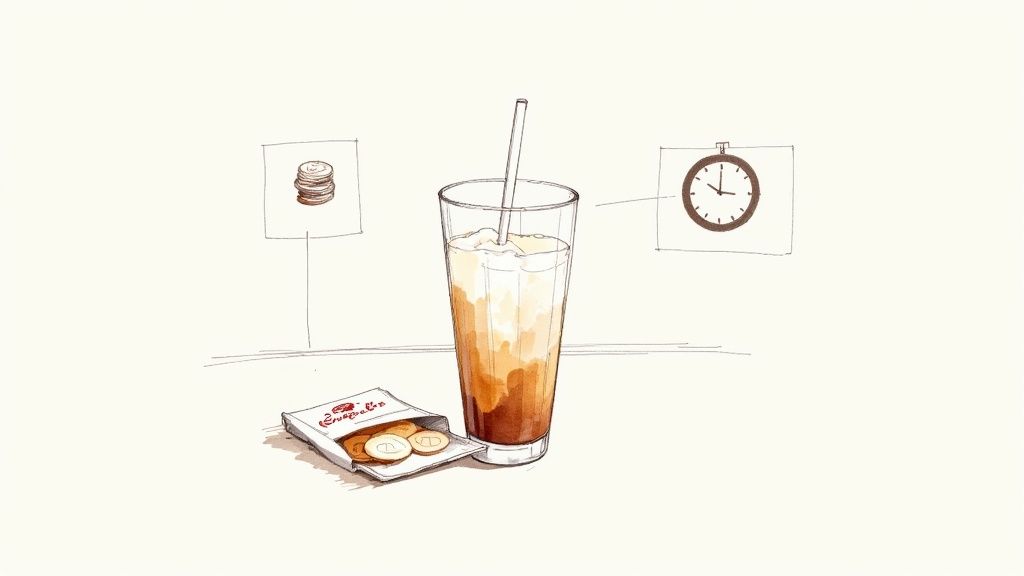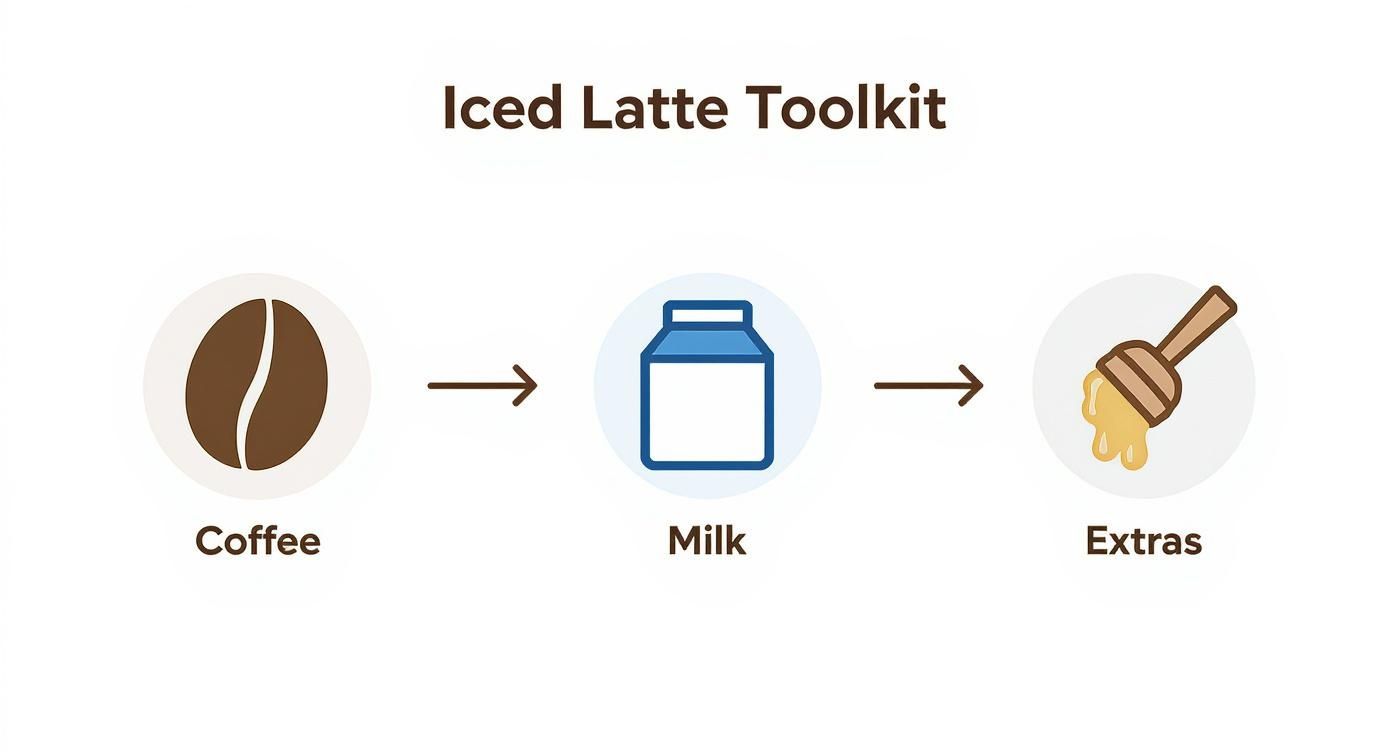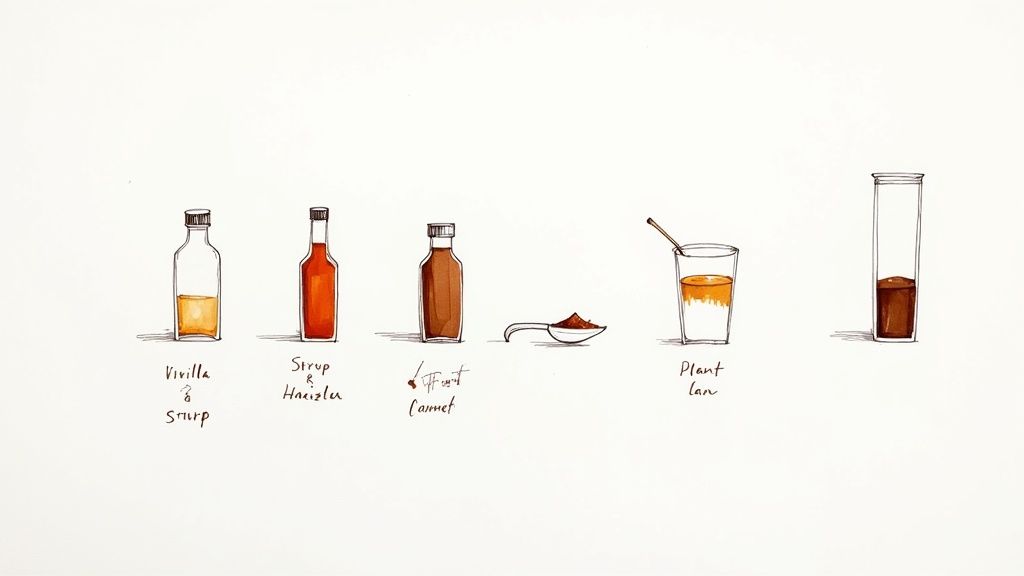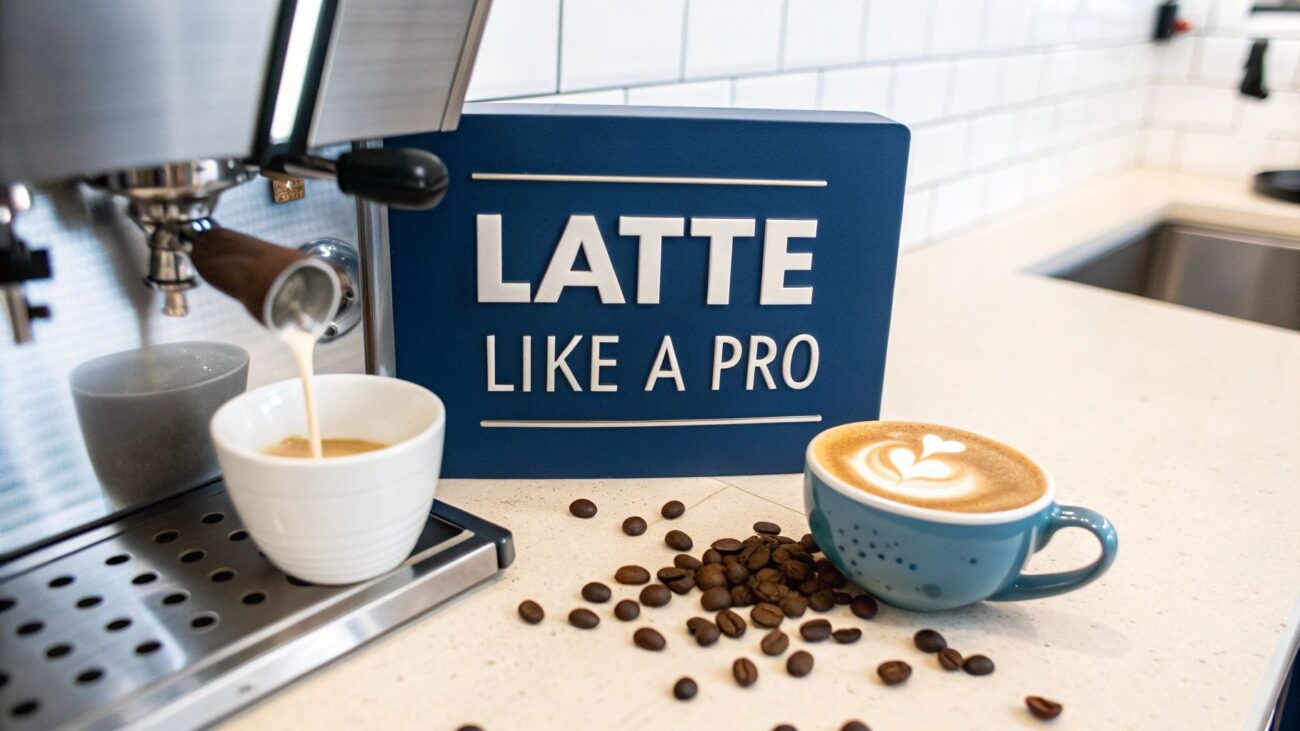How to Make an Iced Latte at Home: A UK Guide

Forget the queues and the pricey café habit. Learning how to make an iced latte at home is far simpler than you might think, really just boiling down to three core parts: a rich coffee base, creamy milk, and plenty of ice. Once you nail a few key techniques, you can get that perfect balance every single time.
Why Your Homemade Iced Latte Can Beat the Café

There's no denying the appeal of a café-bought iced latte, but the satisfaction of crafting your own? That's a real game-changer. It's not just about the obvious cost savings; making your drink at home puts you in the driver's seat. You get to decide the strength of the coffee, the type of milk, and just how sweet you want it, tailoring every sip to your exact preference.
This move towards home-brewed speciality drinks isn't happening in a vacuum. The popularity of iced coffee has absolutely surged in the UK, pointing to a big shift in our tastes. We now get through approximately 98 million cups of coffee daily as a nation, and a growing chunk of that is chilled beverages. This trend is especially strong among younger drinkers who want that café-quality experience without the premium price tag. For a deeper dive, you can discover more insights about UK coffee consumption statistics.
The True Benefits of DIY Drinks
Mastering the homemade iced latte is about more than just saving a few quid; it's about upgrading your daily ritual. When you start with high-quality, freshly roasted beans, you unlock a depth of flavour that pre-ground stuff or pods just can't touch. Imagine using a rich, chocolatey blend from Seven Sisters Coffee Co. that holds its own perfectly against cold milk and ice.
Here’s what you really gain:
- Unmatched Freshness: Your coffee is brewed moments before you drink it. That means all its complex aromas and tastes are preserved, not lost.
- Complete Customisation: From oat milk to a dash of caramel syrup, you are the barista. You can play around with flavours and find your signature combination.
- Convenience and Satisfaction: There's a genuine pleasure in mastering a new skill and enjoying the delicious results right in your own kitchen. No queues, no fuss.
By learning a few simple techniques, you transform a daily expense into a creative and rewarding hobby. It’s about elevating a simple beverage into a moment of genuine daily pleasure, made exactly how you like it.
Getting Your Iced Latte Toolkit Together
Before we jump into pouring that perfect, café-style iced latte, let’s get our gear sorted. Think of it as your pre-flight check—having everything ready makes the whole process smoother and guarantees a delicious result. The best part? You really don't need a professional-grade setup to make an incredible drink right in your own kitchen.
Making iced lattes at home has absolutely exploded across the UK, and a big reason for that is how easy it is to get your hands on great equipment these days. Home coffee culture is thriving. It's not a huge surprise when you think that 80% of UK coffee shop visitors pop in at least once a week. Many of us are now trying to recreate that magic at home.
Choosing Your Coffee Base Brewer
The heart and soul of any latte is a strong, concentrated shot of coffee. While an espresso machine is the traditional route, it's definitely not the only way to get there.
The coffee maker you use is probably the most crucial piece of kit. If you're looking for a new machine, this guide is a great resource for choosing the right coffee machine.
But honestly, you might already have the perfect tool sitting in your cupboard:
- Moka Pot: A true stovetop classic. It brews a rich, dark, espresso-like coffee that’s more than bold enough to stand up to all that milk and ice.
- AeroPress: This little gadget is incredibly versatile. It can press out a concentrated shot that’s smooth, strong, and wonderfully low in acidity.
- French Press: Don't overlook the humble French press. Just use a bit less water and let it brew for longer to create a powerful coffee concentrate that works beautifully as a base.
Whichever method you pick, the aim is the same: a rich, flavourful coffee that won’t get drowned out. For a proper deep dive into pulling that perfect shot, have a look at our guide on how to make an espresso.
To help you decide, here’s a quick rundown of how these common brewing methods stack up for an iced latte base.
Choosing Your Coffee Base: A Quick Comparison
| Brew Method | Flavour Profile | Equipment Cost | Best For |
|---|---|---|---|
| Espresso Machine | Rich, intense, classic crema | £££ | The traditionalist seeking authentic café taste. |
| Moka Pot | Bold, robust, slightly bitter | £ | Achieving an espresso-like kick on a budget. |
| AeroPress | Smooth, clean, low-acidity | £ | Versatility and a quick, easy concentrated shot. |
| French Press | Full-bodied, heavy, rich | £ | Simplicity and making a larger batch of concentrate. |
Ultimately, the best brewer is the one you have and enjoy using. Each one brings its own unique character to the final drink.
Milk, Ice, and Sweeteners
Once you’ve got your coffee sorted, the other elements are just as vital for nailing that perfect texture and taste.
The Milk: The milk you choose can completely change the character of your iced latte. Whole dairy milk gives you that classic, creamy texture we all know and love. But plant-based milks bring their own unique personalities to the party. Oat milk is a superstar for creaminess and pairs beautifully with coffee, while almond milk offers a lighter, nuttier vibe.
The Ice: Don’t just grab any old ice! Your choice here really matters. The goal is to chill your drink right down without turning it into a watery mess. Large, solid cubes are your best friend because they melt much more slowly than small or crushed ice. For the ultimate, undiluted flavour, try making coffee ice cubes ahead of time—it's a game-changer.
Here’s a pro tip: more ice is actually better. A glass packed with ice chills the latte instantly, which means far less dilution. This keeps your drink strong and flavourful from the first sip right down to the last.
The Sweetener: This is where you get to make the drink truly your own. A simple sugar syrup (just equal parts sugar and hot water, stirred until dissolved, then cooled) is a classic for a reason. But don't be afraid to experiment! Maple syrup, agave nectar, or even honey can add wonderful new layers of flavour.
Crafting the Perfect Iced Latte Step by Step
Right, this is the fun part—pulling everything together. Knowing how to make a proper iced latte at home really comes down to the details and, crucially, the order you do things in. Get the flow right, and you'll end up with a drink that's perfectly chilled, beautifully layered, and tastes brilliant from the first sip to the last. This isn't just about chucking ingredients in a glass; it's a small act of craftsmanship.
Before we jump in, remember that the heart of your latte is the coffee itself. To really nail this, it helps to understand the fundamentals. For a deeper dive into the brewing side of things, you can learn more about how to brew a perfect cup of coffee to give your drink the best possible foundation. The better your base, the better the final result.
Prepare and Chill Your Coffee
First things first: brew your coffee. Whether you've just pulled a double shot of rich espresso or made a punchy concentrate in a Moka pot, what you do next is absolutely critical. You have to chill it, and you have to do it quickly. Pouring hot coffee straight over ice is the number one reason for a weak, watery latte.
Your secret weapon here is a simple ice bath. Just place your brewing container—like a small metal jug or the base of your Moka pot—into a larger bowl filled with ice and a bit of cold water. This “flash chilling” technique locks in all those complex coffee flavours without watering them down.
That immediate drop in temperature is what preserves the delicate aromatic compounds that often disappear when hot coffee cools down slowly. It means a much more flavourful drink for you, and it only takes a minute or two to make a world of difference.
Assemble Your Iced Latte
With your coffee nicely chilled and ready to go, it's time to build your drink. This part is a bit of science and a bit of art, aiming for something that not only tastes fantastic but looks the part, too.
- Fill your glass with ice: Grab your favourite tall glass and be generous with the ice cubes. Don't hold back! Packing the glass full means your drink chills instantly and the ice melts much more slowly, so you get less dilution.
- Pour in the milk: Next, pour your chosen milk over the ice until the glass is about two-thirds to three-quarters full. This leaves just the right amount of room for the star of the show.
- Add the chilled coffee: Now for the grand finale. Slowly pour your chilled espresso or coffee concentrate over the milk and ice. If you do this carefully, you'll see the coffee cascade down through the milk, creating that beautiful marbled effect that makes an iced latte so appealing.
- Sweeten and stir: If you're using a sweetener like simple syrup or a drizzle of maple syrup, this is the moment to add it. Give it all a good stir to combine the layers, and your perfect homemade iced latte is ready to go.
And for those days when you're craving the classic hot version, our complete recipe for a latte has all the tips you need for a traditional, steaming cup.
This simple workflow breaks down the essentials for building your drink, focusing on getting each component just right.
The key takeaway is that every element—the strong coffee, the creamy milk, and any optional extras—plays its own distinct role. By following these steps, you’re not just mixing a drink; you’re crafting a perfectly balanced and refreshing experience, right in your own kitchen.
Elevating Your Iced Latte With Flavours and Variations
Once you’ve nailed the classic iced latte, the real fun begins. This is where you can start to experiment and create a drink that’s uniquely yours. Moving beyond the standard recipe opens up a world of delicious possibilities, turning your daily coffee from a simple routine into a creative ritual.
Forget about those expensive, artificially flavoured syrups. Creating your own at home is incredibly simple and gives you a much richer, more authentic taste. All it takes is equal parts sugar and water, heated gently until the sugar dissolves. Let it cool, and you have the perfect blank canvas.
Crafting Delicious Homemade Syrups
A basic simple syrup is a great start, but infusing it with flavour is where the magic really happens. With just a few common ingredients you likely already have in your cupboard, you can create drinks that rival any high-street café.
- Vanilla Latte: For that timeless classic, add a teaspoon of good-quality vanilla extract or a scraped vanilla pod to your syrup as it cools. The flavour is far superior to anything from a bottle.
- Caramel Latte: To make a rich caramel sauce, melt sugar in a pan until it turns a deep amber colour, then carefully stir in a splash of double cream and a pinch of salt. It’s wonderfully decadent.
- Hazelnut Latte: A few drops of hazelnut extract added to your simple syrup will give you that nutty, comforting flavour many of us love.
These homemade syrups can be stored in an airtight container in the fridge for several weeks, ready for you to add a spoonful whenever you fancy a flavoured iced latte.
The beauty of making your own syrups is total control. You decide on the sweetness and the intensity of the flavour, ensuring every single drink is perfectly tailored to your palate.
Beyond syrups, simple spices can add a wonderful warmth and complexity. A sprinkle of cinnamon or a grating of nutmeg over the top can instantly turn your standard iced latte into a spiced delight, perfect for a cooler day.
For a truly indulgent treat, try making an iced mocha. Just whisk cocoa powder and a little sugar into your hot coffee shot before chilling it—the result is a rich, chocolatey drink that feels like a special occasion.
Another fantastic variation is using a different coffee base entirely. For a smoother, less acidic profile, check out our guide on how to make cold brew coffee. Its naturally mellow character is an excellent foundation for flavoured drinks.
Embracing Dairy-Free Alternatives
The rise of plant-based milks has completely transformed the coffee scene, and for good reason. Choosing a dairy-free alternative isn't just a dietary choice; it's a way to introduce new textures and flavour notes to your iced latte.
The increasing popularity of these options at home reflects a huge trend across the UK. In fact, the UK plant-based milk market is now valued at over £230 million and is expected to grow by 8% annually as more people seek out different options for their coffee.
However, not all plant-based milks behave the same way in coffee.
- Oat Milk: This is the undisputed champion for creaminess. Its naturally sweet and neutral flavour allows the coffee to shine through, creating a texture remarkably similar to dairy.
- Almond Milk: A lighter option with a subtle nutty taste. It’s less creamy but offers a refreshing alternative that pairs especially well with vanilla or caramel flavours.
- Soya Milk: With its high protein content, soya milk froths well and has a distinct, slightly beany flavour that some people absolutely love with their coffee.
To help you find your perfect match, here’s a quick guide to some of the most popular milk and milk-alternative options for your iced latte.
Milk and Milk Alternative Pairing Guide
Discover the best milk options for your iced latte, comparing flavour, creaminess, and how well they pair with coffee.
| Milk Type | Flavour Notes | Creaminess Level | Pairs Best With |
|---|---|---|---|
| Whole Milk | Rich, slightly sweet | High | Classic espresso, strong coffee |
| Oat Milk | Neutral, naturally sweet | High | Virtually any coffee, especially medium roasts |
| Almond Milk | Light, nutty | Low | Lighter roasts, vanilla or caramel syrups |
| Soya Milk | Distinct, slightly savoury | Medium | Dark roasts, chocolatey or spiced flavours |
| Coconut Milk | Tropical, sweet | Medium | Lighter, fruitier coffees; creates an exotic twist |
This table is just a starting point, of course. The best way to find out what you love is to try a few different combinations.
Experimenting with these variations is the key to discovering your perfect homemade iced latte. Don't be afraid to mix things up and find a new favourite.
Sorting Out Common Iced Latte Problems
Even with the best intentions, your home-barista journey can hit a few snags. Don't stress—it happens to the best of us. Most issues are surprisingly easy to fix and usually just need a small tweak to your method or ingredients.
The most common complaint I hear is about watery, weak-tasting lattes. If that sounds painfully familiar, the culprit is almost always temperature control. Pouring hot—or even just warm—coffee straight over ice is a guaranteed recipe for instant dilution. It turns a beautifully rich, bold brew into a sad, watered-down drink.
Solving Watery or Weak Lattes
The fix here is twofold: use more ice and, most importantly, chill your coffee before it meets the ice in your glass. Always pack your glass right to the brim with large ice cubes; they melt much, much slower than smaller ones. The game-changer, though, is to flash-chill your freshly brewed coffee. Just place your brewing vessel in a bowl of ice and water for a few minutes. This simple step locks in all that amazing flavour without melting your ice.
Adjusting for Bitterness or a Lack of Punch
Sometimes the problem isn't dilution, but the coffee base itself. If your latte tastes overly bitter, your coffee is probably over-extracted. This often happens if your grounds are too fine or you let it brew for too long.
On the flip side, a latte that just tastes "milky" without a real coffee kick is likely under-extracted. This usually points to your coffee-to-water ratio being off or your grind being far too coarse for the job.
- For Bitterness: Try using a slightly coarser grind. This lets water pass through more freely, which reduces the extraction of those bitter compounds.
- For Weakness: A finer grind will increase the extraction, giving you more flavour. Alternatively, just use more coffee grounds for the same amount of water to brew a stronger concentrate.
Getting the grind size right can make all the difference in the world. To really get a handle on it, check out our complete coffee grind size guide, which breaks it all down for pretty much any brewing method you can think of.
Fixing Thin or Separated Textures
Another frustrating one is the latte that looks thin or separates a moment after you’ve proudly made it. This almost always comes down to the milk you’re using and how you pour it.
The goal is a creamy, homogenous drink, not a layered science experiment. Achieving this comes down to choosing milk with enough fat and protein to blend smoothly with the coffee's oils and acidity.
Whole dairy milk is a classic for a reason—its creamy texture is incredibly reliable. If you're going for plant-based, a "barista blend" oat milk is your best bet. They're specifically formulated to resist separating in coffee. A final pro tip: pour the chilled coffee slowly over the milk and ice, not the other way around. It helps create a far more stable and visually stunning drink.
Common Questions About Making Iced Lattes
Even when you've got the basics down, a few questions always seem to pop up when you're trying to perfect your iced latte at home. Let's get them answered so you can build your confidence and troubleshoot like a pro.
Can I Make an Iced Latte Without an Espresso Machine?
Absolutely. You don’t need a pricey, countertop-hogging machine to make a brilliant iced latte. The goal is simply to brew a strong, concentrated coffee base that won’t get lost when you add milk and ice.
Chances are, you already have what you need:
- Moka Pot: This classic stovetop brewer makes a rich, intense, espresso-like coffee that’s perfect for the job.
- AeroPress: Use a fine grind and a quick, firm plunge to create a beautifully smooth and potent shot of coffee.
- French Press: To get a strong concentrate, just double your usual coffee-to-water ratio. Let it steep for an extra minute or two to really pull out those deep, robust flavours.
How Do I Stop My Iced Latte From Getting Watery?
This is the number one complaint I hear, but thankfully, it's an easy fix. A weak, watery latte is almost always caused by pouring hot coffee directly over ice. The ice melts instantly, diluting all that delicious flavour you worked so hard to create.
The secret is all about temperature control. You absolutely have to chill your coffee shot before it hits the ice. It’s a game-changer.
To get the best results, start by filling your glass to the top with ice—bigger cubes melt slower. Flash-chill your freshly brewed coffee by swirling it in a separate cup plunged into an ice bath for a minute. If you want to go the extra mile, make a tray of coffee ice cubes ahead of time for a truly undiluted drink.
What Is the Best Coffee to Milk Ratio?
A fantastic starting point for a well-balanced iced latte is a ratio of one part coffee to three parts milk. So, if you're using a 60ml double shot of coffee, you'd add about 180ml of milk.
But think of this as a guideline, not a rigid rule. Your personal taste is what really counts. If you like a bolder, more coffee-forward drink, try a one-to-two ratio. For something creamier and milder, you could even push it to one-to-four. The best way forward is to play around and find what tastes perfect to you. For a bit more guidance on measurements, you can learn about how many tablespoons per cup of coffee is a good starting point for any brewing method.
Ready to brew your perfect iced latte? The foundation of any great coffee drink is exceptional beans. Explore the incredible range of single-origin and blended coffees at Seven Sisters Coffee Co and discover the difference freshly roasted, high-quality beans can make. Shop our coffee collection today.







